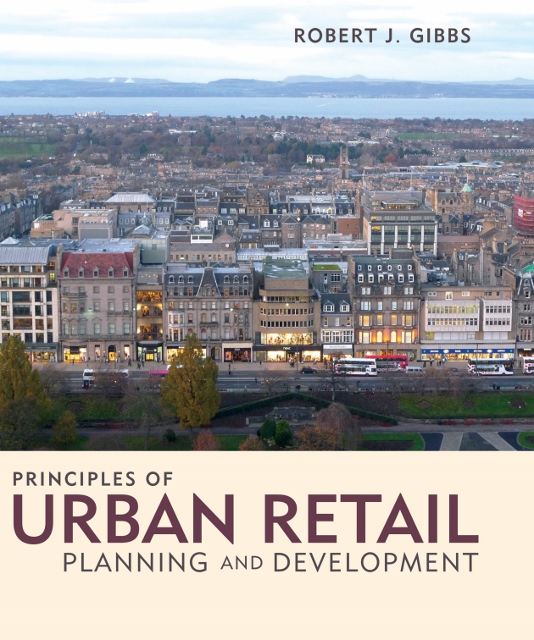Principles of Urban Retail Planning & Development: a Roadmap to Making Cities & Towns Economically Resilient & Livable
Gibbs Planning Group
By Robert J. Gibbs, ASLA, CNU-A
"...Extraordinary: Gibbs has popped the hood and taken apart the engine of commercial design and development, showing us each individual part and explaining fit, form and function."
—Yaromir Steiner, Founder, Chief Executive Officer, Steiner + Associates
"...the most comprehensive and expansive book ever written on the subject of Retail Real Estate Development. Gibbs is by far the most prominent advocate for reforming retail planning and development in order to return American cities to economic and physical prominence."
–Stefanos Polyzoides, Moule & Polyzoides Architects & Urbanists
 "Principles of Urban Retail Planning & Development," a new book by Michigan consultant Robert Gibbs, ASLA is based on Gibbs’ 30 years of urban design and planning practice. Written from an insider’s perspective, the book reveals the retail industry’s current principles and practices for implementing sustainable commerce—the knowledge needed to increase retail sales and market share in historic urban centers and ensure their viability in new ones. This book focuses on explicating the retail principles for restoring neighborhoods, villages, towns, and urban commercial districts to their traditional roles as the local and regional centers for commerce and trade.
"Principles of Urban Retail Planning & Development," a new book by Michigan consultant Robert Gibbs, ASLA is based on Gibbs’ 30 years of urban design and planning practice. Written from an insider’s perspective, the book reveals the retail industry’s current principles and practices for implementing sustainable commerce—the knowledge needed to increase retail sales and market share in historic urban centers and ensure their viability in new ones. This book focuses on explicating the retail principles for restoring neighborhoods, villages, towns, and urban commercial districts to their traditional roles as the local and regional centers for commerce and trade.
Urban retail design and shopping center development constitute two of the most important, but least understood, elements by many landscape architects. Municipal authorities, city planners and real estate developers have widely differing views on how best to implement new retail. Although well intended, many public policies have resulted in hindering the viability and growth of commerce in historic cities and new towns. Unfortunately, such actions were based on gross misunderstandings of how commerce works in urban environments—the retail rules that often conflict with the accepted tenets of urban design and planning.
In easy to understand dialog, the book describes and illustrates the relationships between commercial real estate finance and development and the psychology of commerce—the practical art of analyzing and adjusting all elements known to affect a shopper’s state of mind, from the location and design of all sizes of buildings (including large format department stores), liner retail, parking and streetscape to the level of site lighting. It features research and case studies in Alaska, California, Canada, Florida, Illinois, Maine, Michigan, Ohio, Oregon, Scotland, North Carolina, South Carolina, Texas and Wisconsin.
Gibbs has merged proven retail industry techniques for building typology, business models, lighting, historical centers, parks, parking, pavers, signage, streetscape, trees and zoning policy into diagrams and explanations that can be easily understood by citizens, landscape architects, real estate developers and public policy makers.
The principles outlined in this book are not intended to replace traditional urban planning practices. Rather, they constitute a guide to help planners and policy makers master basic yet essential retail principles that when disregarded or misconstrued can have grave economic consequences. The applications are intended to help planners design and communicate with their private and public clients on how to revive downtown retail and retrofit failed suburban centers, as well as plan new towns.
The book is a 2012 Merit Award recipient from Michigan ASLA.
ABOUT THE AUTHOR:
Robert Gibbs is considered one of the foremost urban retail planners in America. For more than two decades, his expertise has been sought by some of the most respected mayors, renowned architects and successful real-estate developers in the country. Profiled in The New York Times, The Wall Street Journal and Urban Land, Gibbs has, writes Atlantic Monthly, "a commercial sensibility unlike anything possessed by the urban planners who usually design downtown-renewal efforts." Mayor Joseph P. Riley called Gibbs's retail plan for Charleston, "The Bible for the future of our historic district."
A speaker at the First Congress of the New Urbanism in 1992 and eight subsequent CNUs, Gibbs has lectured throughout the country and contributed articles to numerous books and publications. Of particular note is his authorship of the SmartCode Retail Module. For the past 17 years, he has taught an Urban Retail Planning course in the Executive Education Program at the Harvard Graduate School of Design.
Published by Wiley & Sons
Available online at amazon.com & barnesandnoble.com
Posted April 16, 2013
Want to see more events?

Planetizen Courses: Online Training in Urban Planning
Access more than 250 urban planning courses on your computer, phone, or tablet. Learn today, plan for tomorrow.


Planetizen AICP* Exam Prep Class
90% of students who took our class passed the exam and became AICP* certified.

Get your event noticed today.
Caltrans
City of Fort Worth
City of Portland
City of Laramie
























